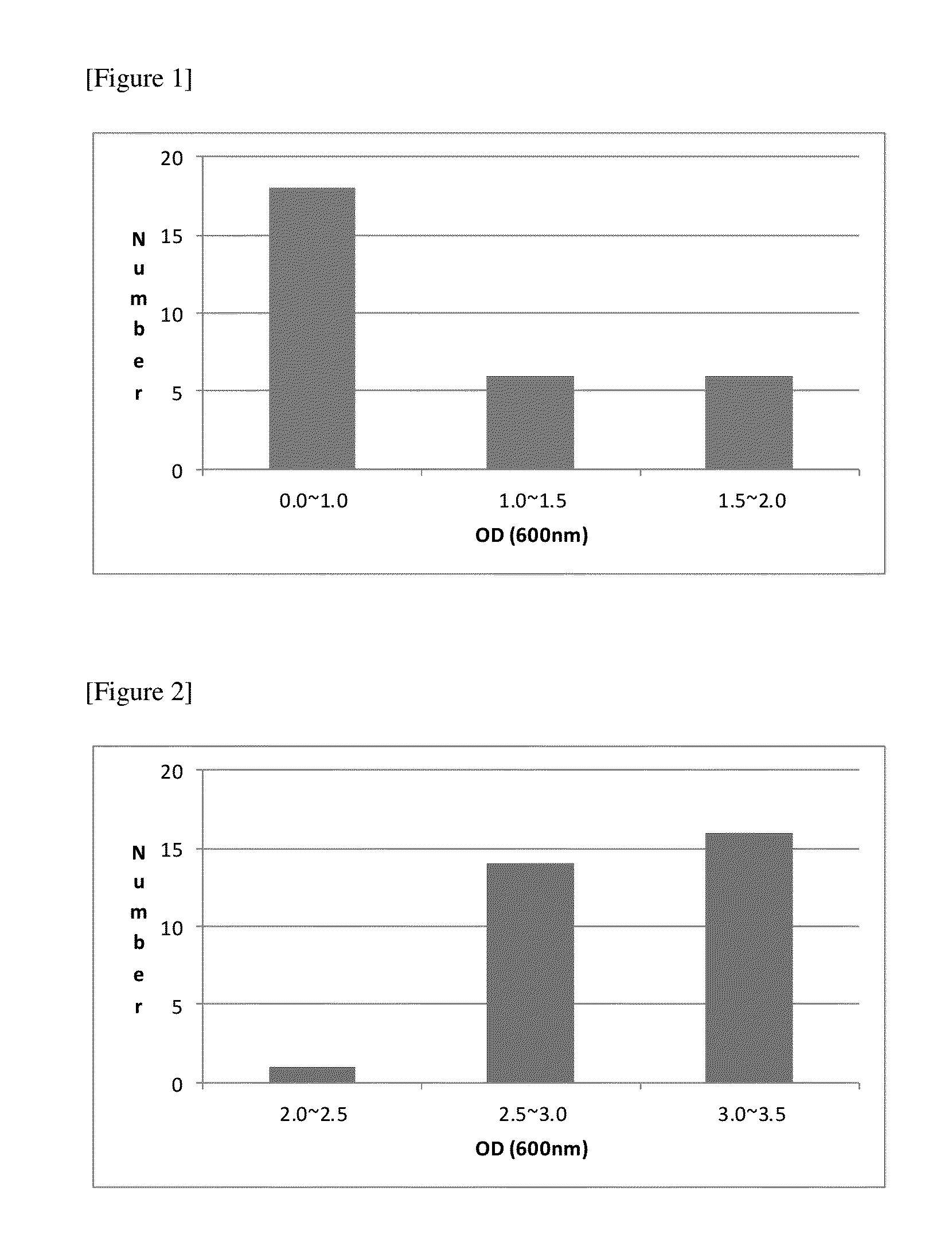Hyphomicrobium sp. microorganism and method of producing pyrroloquinoline quinone using the same
a technology of pyrroloquinoline and microorganisms, which is applied in the field of hypohomicrobium sp. microorganisms and methods of producing pyrroloquinoline quinone using the same, can solve the problems of difficult to reduce the production cost of mass-producing pyrroloquinoline, inability to grow, and long culture period of mass production, so as to improve the recovery rate, increase the productivity of pyrroloquinoline quinone, and the metabolic activity of the strain
- Summary
- Abstract
- Description
- Claims
- Application Information
AI Technical Summary
Benefits of technology
Problems solved by technology
Method used
Image
Examples
example 1
Production of Hyphomicrobium sp. SWB-P91 (KCTC12695BP) Mutant Strain
[0039]A Hyphomicrobium sp. parent strain, Hyphomicrobium denitrificans (ATCC51888), cultured in a complete plate medium (methanol 0.2%, ammonium sulfate 0.3%, potassium monohydrogen phosphate 0.14%, disodium phosphate 0.21%, serine 0.02%, magnesium sulfate 0.1%, ferrous citrate 0.003%, calcium chloride 0.003%, manganese sulfate 0.0001%, zinc sulfate 0.002%, copper sulfate 0.00001%, agar 1.5%, pH 7.0) at 30° C. for 72 hours was inoculated into a complete liquid medium and cultured at 30° C. for 48 hours. The term “%” of the concentration of the medium means wt %. After the culture, the culture solution was centrifuged at 12000 rpm for 15 minutes, and the resultant bacterial cells were washed with saline twice. The bacterial cells were suitably diluted with the saline to have a concentration of the bacterial cells of about 1 OD (600 nm), and treated with 250 μg / ml N-methyl-N′-nitro-N-nitroguanidine (NTG) at 30° C. for...
example 2
Comparison in Productivity of Pyrroloquinoline Quinone Between Hyphomicrobium sp. SWB-P91 (KCTC12695BP) Mutant Strain and Parent Strain
[0042]1.8 l of a fermentation growth medium (methanol 1%, ammonium sulfate 0.3%, potassium monohydrogen phosphate 0.14%, disodium phosphate 0.21%, serine 0.02%, magnesium sulfate 0.1%, ferrous citrate 0.003%, calcium chloride 0.003%, manganese sulfate 0.0001%, zinc sulfate 0.002%, copper sulfate 0.00001%, pH 7.0) was poured into a 5 l small fermenter and sterilized at 121° C. for 20 minutes. 200 ml of a seed culture solution cultured in the same medium at 30° C. and 120 rpm for 48 hours was inoculated into the fermenter, and fermentation was performed under conditions of 500 rpm and 1 vvm at 30° C. for 150 hours. The pH of the fermenting solution was adjusted with ammonia water to a pH of 7, methanol was added during the fermentation in a fed-batch fermentation process, and pyrroloquinoline quinone productivity of the strain was measured. In the fed-...
example 3
Comparison of Growth Degrees by Serine Addition to Medium
[0043]Comparative experiments were carried out to check if stable approach from a lag phase to an exponential growth phase after the addition of serine to medium components occurred. To this end, 10% of the Hyphomicrobium SWB-P91 strain was inoculated as a seed into 30 flasks containing serine-free and 0.002% serine-containing complete liquid medium (methanol 0.2%, ammonium sulfate 0.3%, potassium monohydrogen phosphate 0.14%, disodium phosphate 0.21%, magnesium sulfate 0.1%, ferrous citrate 0.003%, calcium chloride 0.003%, manganese sulfate 0.0001%, zinc sulfate 0.002%, copper sulfate 0.00001%, pH 7.0) and cultured at 30° C. and 120 rpm for 30 hours, and then degrees of the growth in the media were compared to each other.
[0044]In the serine-free medium, as shown in FIG. 1, a low degree of growth and the irregular progression to the exponential growth phase were observed, but in the serine-containing medium, as shown in FIG. 2...
PUM
| Property | Measurement | Unit |
|---|---|---|
| Density | aaaaa | aaaaa |
| Concentration | aaaaa | aaaaa |
| Adsorption entropy | aaaaa | aaaaa |
Abstract
Description
Claims
Application Information
 Login to View More
Login to View More - R&D
- Intellectual Property
- Life Sciences
- Materials
- Tech Scout
- Unparalleled Data Quality
- Higher Quality Content
- 60% Fewer Hallucinations
Browse by: Latest US Patents, China's latest patents, Technical Efficacy Thesaurus, Application Domain, Technology Topic, Popular Technical Reports.
© 2025 PatSnap. All rights reserved.Legal|Privacy policy|Modern Slavery Act Transparency Statement|Sitemap|About US| Contact US: help@patsnap.com

